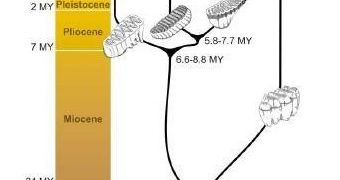Humans and elephants evolved in the same African dry savanna. That's why elephant fossils offer a clue on the type of environment in which our ancestors lived. An analysis of DNA painstakingly retrieved from an ancient mastodon tooth has further pushed back the time when mammoths split off from elephants. It appears that the mammoths and Asian elephants split about 5.8 to 7.7 million years ago when humans and apes could have shared a common ancestor.
It appears that environmental changes at the time caused a massive period of speciation (species formation) in Africa. "Until recently, scientists believed that humans and chimps last shared a common ancestor about 5 million years ago. But fossil studies and genetic discoveries in recent years have pushed this date back by at least 1 million years." said Paul Matheus at the University of Alaska in Fairbanks, US.
Now, Matheus team employs a mastodon tooth recovered in Alaska to revise the evolutionary history of mammoths and elephants, previously believed to have diverged from each other about 5 million years ago. Mastodons are elephant related animals, with elephant-like build, but with straighter tusks, longer body, longer head, shorter limbs and more primitive teeth. Fossil data showed that mastodons split from elephants about 24 million to 28 million years ago.
The Alaskan mastodon tooth was estimated to be 50,000 to 130,000 years old. The mastodon DNA was extracted from 30 grams of ground tooth. They sequenced the whole mitochondrial DNA of the mastodon, about 16,000 pairs of nucleotid pairs. They were compared with similar DNA sequences from African elephants, Asian elephants and mammoths (mammoths were just hairy species of elephants).
As the fossils showed mastodons split off from elephants about 26 million years ago, the researchers could calculate the rhythm of mutation accumulations in time, called the evolutionary clock. The evolutionary clock of the elephants revealed that African elephants diverged from Asian elephants and mammoths about 6.6-8.8 million years ago. Then mammoths and Asian elephants could have split about 5.8-7.7 million years ago, about the same time when humans and chimps took different evolutionary pathways.
"I think it's interesting that you have two biologically different groups diverging in Africa at the same time," says Hofreiter, referring to the elephant species and the ape-human species.
These similarities in the timelines enhance the hypothesis that a change towards drier climes in Africa triggered the emergence of these new species. Drier climate provoked habitat fragmentation, and in isolated patches of forests, divergent species evolved.

 14 DAY TRIAL //
14 DAY TRIAL //